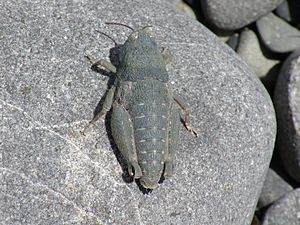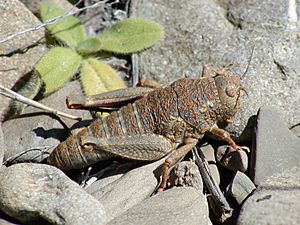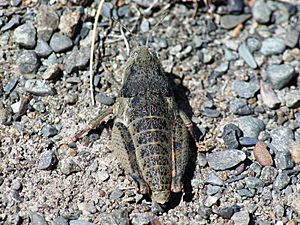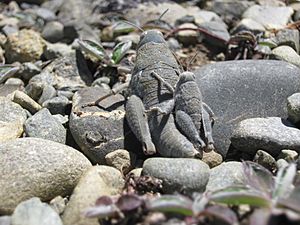Robust grasshopper facts for kids
Quick facts for kids Robust grasshopper |
|
|---|---|
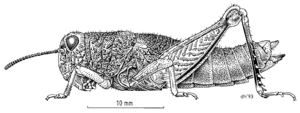 |
|
| Brachaspis robustus illustrated by Des Helmore | |
| Conservation status | |
 Nationally Endangered (NZ TCS) |
|
| Scientific classification | |
 |
|
| The distribution of B. robustus in New Zealand |
The Brachaspis robustus, also known as the Robust grasshopper, is a special type of grasshopper. It is found only in the Mackenzie Basin of the South Island of New Zealand. This means it is endemic to that area. Sadly, it is a nationally endangered species.
Even though it's a grasshopper, it's not very good at jumping far. Instead, it uses its amazing camouflage to hide from animals that might want to eat it. It is in danger because of animals like stoats, hedgehogs, and rats that were brought to New Zealand.
Dr. Tara Murray, an expert on insects in New Zealand, said in 2019: "They can actually jump, they just don’t land very well." She explained that on a warm day, an adult male can jump up to 1.5 meters (about 5 feet) many times. Female grasshoppers are bigger, so they don't jump as far. These grasshoppers often freeze still as their first way to defend themselves. If they do jump, they might land awkwardly, like a "belly flop"!
Contents
What the Robust Grasshopper Looks Like
The Robust grasshopper is incredibly good at hiding. Its body colors and patterns help it blend in perfectly with its surroundings. This is called crypsis, and it helps protect them from predators.
Male and female Robust grasshoppers look different in size. This is called sexual dimorphism. Adult males are about 18–22 millimeters (0.71–0.87 inches) long. Adult females are much larger, measuring 38–42 millimeters (1.5–1.7 inches).
Young grasshoppers, called nymphs, grow through stages. Males usually have 5 growth stages, and females have 6. The wings on the Robust grasshopper are very tiny, only 1–2 millimeters (0.04–0.08 inches) long. This means they cannot fly, just like most other grasshoppers in New Zealand.
There are three main color types, or morphs, for adult Robust grasshoppers:
- Grey: This is the most common color, found in about 60% of adult grasshoppers.
- Orange: About 40% of adult grasshoppers are this color.
- Black: This color is very rare, found in less than 0.5% of them.
Where the Robust Grasshopper Lives
The Robust grasshopper is only found in the Mackenzie Basin of New Zealand. Specifically, it lives near the Tekapo, Pukaki, and Ohau rivers.
You can find them as far south as Lake Benmore and as far north as the upper Fork Stream. They live at different heights, from about 352 meters (1,155 feet) near the lower Ohau River up to 1,060 meters (3,480 feet) in the upper Fork Stream. Experts have searched the Mackenzie Basin since 1980, so we now have a good idea of where they live.
Life Cycle and Reproduction
The Robust grasshopper usually lives for about two years. Female grasshoppers lay their eggs from early summer to mid-autumn. They probably lay two groups of eggs each season, with 20–32 eggs in each group.
Most young grasshoppers (nymphs) hatch in mid-summer. However, some early nymphs have been seen later in the season. It is thought that the eggs need to experience a winter period to develop fully before hatching. This is common for many New Zealand grasshoppers.
The nymphs then spend the winter months, often surviving in temperatures well below freezing. They grow into adult grasshoppers the following summer.
The number of male and female Robust grasshoppers changes throughout the New Zealand summer:
- November (early summer): About 56% are male and 44% are female.
- December: Females become more common, with 57% females and 43% males.
- January: Males are more common again, with 54% males and 46% females.
- March (late summer): Males are much more common, with 82% males and only 18% females.
Habitat and What They Eat
Robust grasshoppers are always found in very rocky places. These include stony riverbeds and areas where glaciers or rivers have left behind rocks. They are never found living in plants.
They are generalist herbivores, which means they eat many different kinds of plants. They are known to eat certain grasses like Anthosachne scabra and Poa pratensis. They also eat a herb called Achillea millifolium, as well as mosses and lichens.
Studies of their droppings in spring showed that moss and lichen are important parts of their diet. This might be because mosses and lichens can absorb moisture at night. Since the Mackenzie Basin can be very dry, these plants may help the grasshoppers get enough water.
Conservation Efforts
The Robust grasshopper is one of two grasshopper species in New Zealand protected by the Wildlife Act 1953. The other is Sigaus childi. Another species, Sigaus takahe, is also protected because it lives in a special protected area.
People noticed that the Robust grasshopper was rare as early as the 1960s. In 1993, experts thought there were only about 800 adult grasshoppers left in the wild. By the end of 2009/2010 summer, this number had dropped to about 600 adults.
In 1993, most of the grasshoppers were found in three large groups. By 2010, many new smaller groups had been found. However, the three main groups from 1993 had become very spread out and broken into many tiny groups. One of the biggest threats to the Robust grasshopper is introduced mammals like stoats, hedgehogs, and rats.
To help protect them, 20 Robust grasshoppers were fitted with tiny radio transmitters in December 2017. These transmitters worked for 3–12 days and helped scientists learn how far the grasshoppers move. This information is important for moving them to new safe places in the future.
In July 2018, a 440-hectare area in the Mackenzie Basin, called the "Tekapo Triangle," was made into a special reserve for the Robust grasshopper. Also, six pairs of Robust grasshoppers were taken into captivity. Scientists hope to breed them safely to help increase their numbers.


